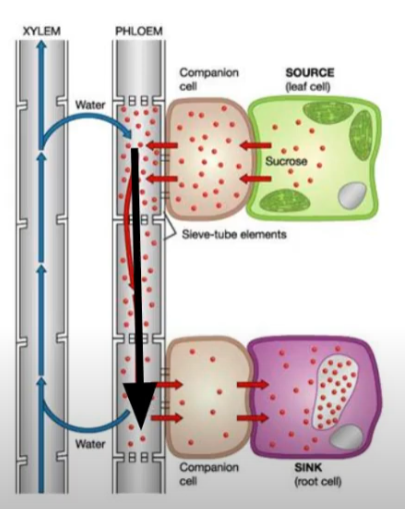3.3 Transport in Plants
1/64
There's no tags or description
Looks like no tags are added yet.
Name | Mastery | Learn | Test | Matching | Spaced |
|---|
No study sessions yet.
65 Terms
Why do plants need a transport system?
There is a large surface area to volume ratio
The rate of diffusion into plant tissues is too slow.
There's a high metabolic rate
What do plants need to exchange with the living environment?
It takes in CO₂ and nutrients
Waste products need to be released
Why can't large transport distances use simple diffusion?
Diffusion wouldn't be fast enough to meet the metabolic requirements of cells
How is glucose transported throughout the plant?
As sucrose
How do plants adapt to increase their SA:V ratio?
Plants have a branching body shape
Leaves are flat and thin
Roots have root hairs
Metabolic activity in the plant
Larger organisms are more physically active and contain more cells than smaller organisms
A larger number of cells results in a higher level of metabolic activity, and as a result, the demand for oxygen and nutrients is greater, and more waste is produced
What is mass flow?
The bulk movement of materials. It is directed movement so involves some source of force.
Why have plants evolved to have specialised mass flow transport systems?
To enable the efficient transport of nutrients
What do mass transport systems help to do?
Bring substances quickly from one exchange site to another
Maintain the diffusion gradients at exchange sites and between cells and their fluid surroundings
Ensure effective cell activity by keeping the immediate fluid environment of cells within a suitable metabolic range
What 2 separate mass transport systems exist in flowering plants?
Xylem
Phloem
What does the xylem transport?
Water and Mineral Ions
What does the phloem transport?
Sucrose and amino acids (assimilates)
Why don't plants have a specialised transport system for oxygen and carbon dioxide?
They have adaptations that give them a high SA:V ratio for the absorption and diffusion of gases
The leaves and stems possess chloroplasts, which produce oxygen and use up carbon dioxide
There is a low demand for oxygen, due to plant tissues having a low metabolic rate
Where are xylem and phloem found?
In vascular bundles
Vascular bundle in a leaf
Xylem on top
Phloem underneath
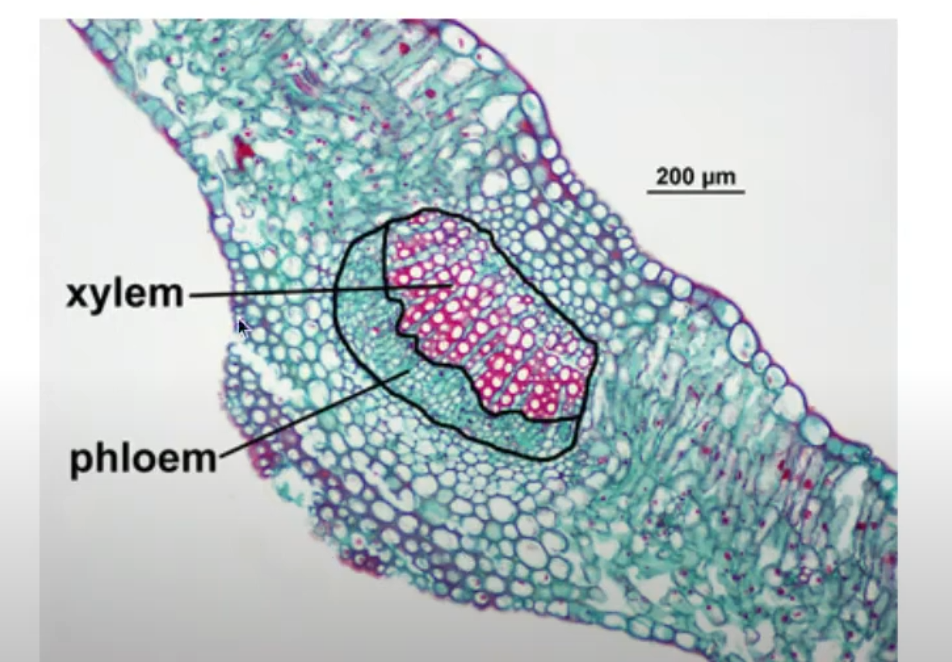
Vascular bundle in a stem
Phloem in the outer
Cambium in between
Xylem near the centre
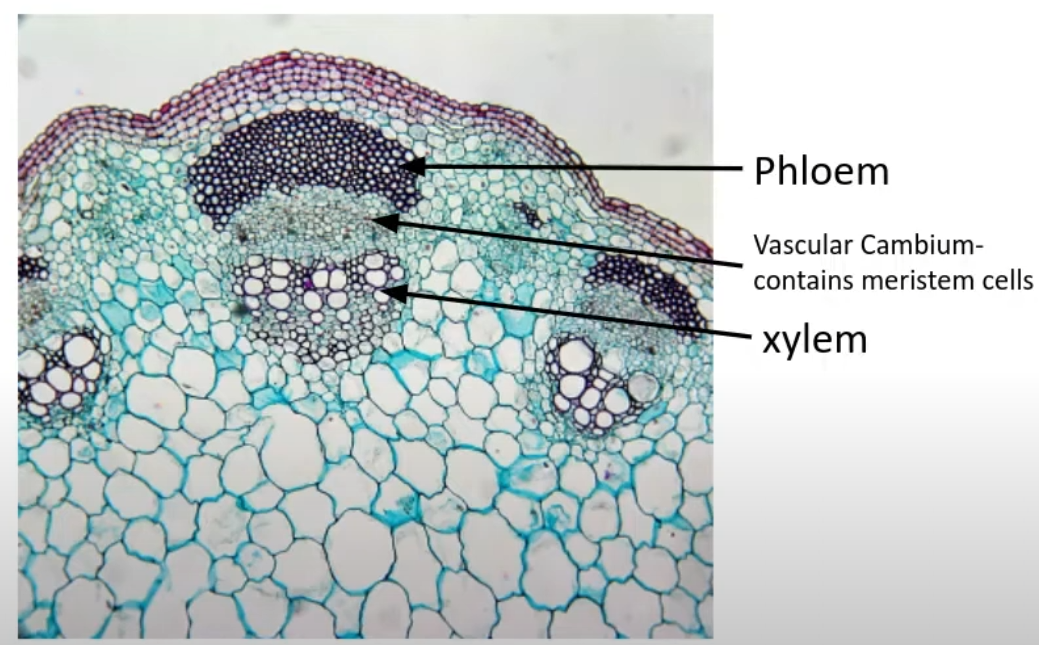
Vascular bundle in the root
x shape in the middle is the xylem
Phloem bundles around the xylem
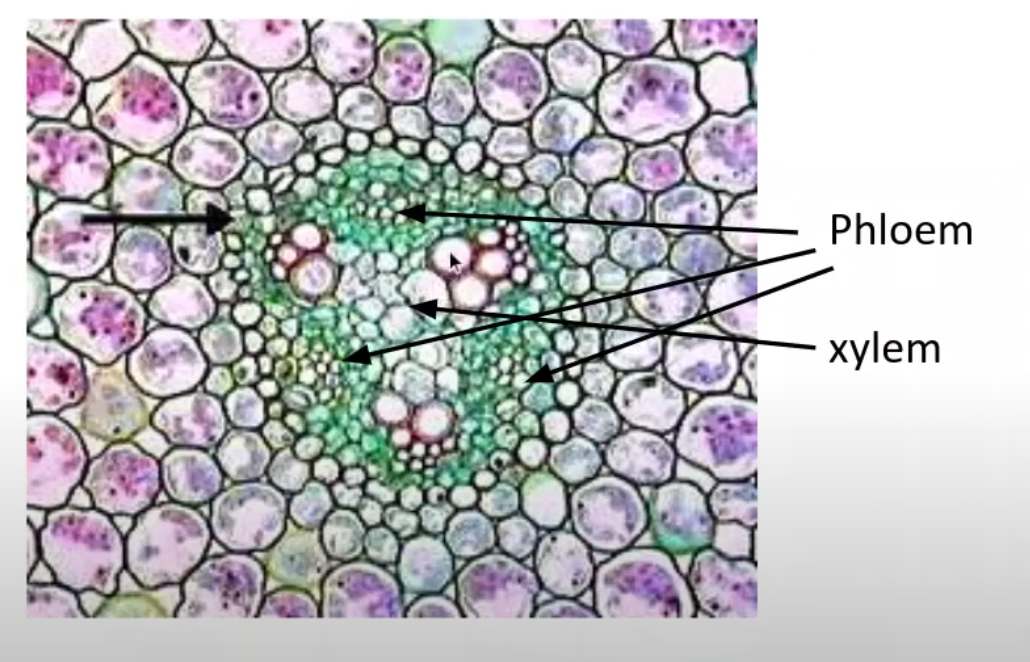
Dicotyledonous plant roots
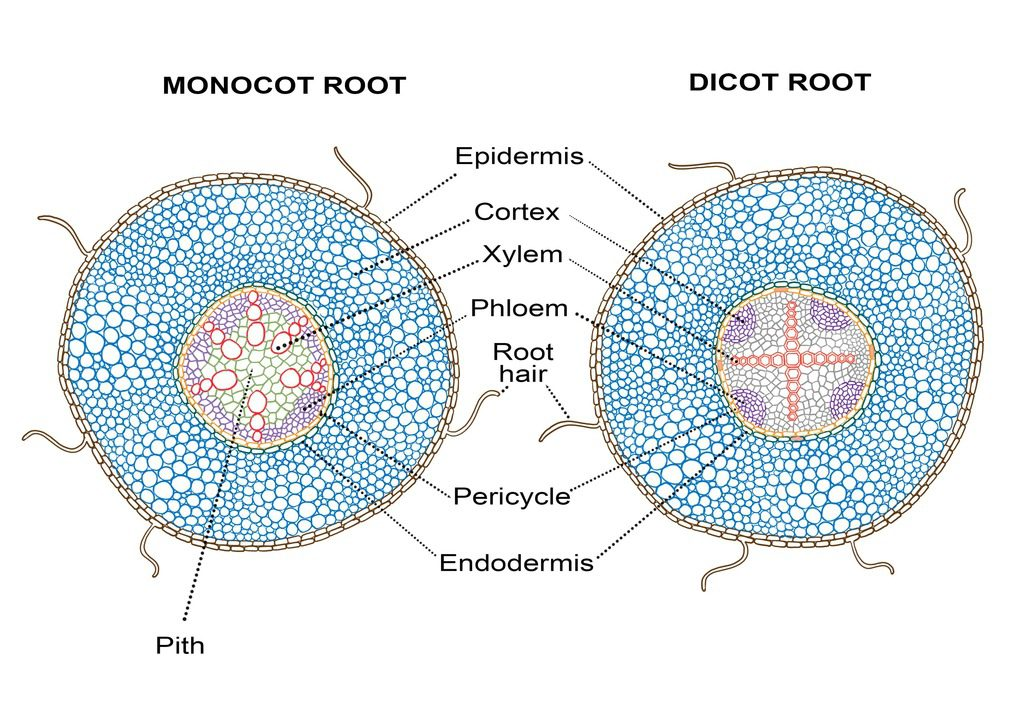
Definition of transpiration
The evaporation of water from the stomata
Definition of transpiration stream
The movement of water up the xylem
Evapotranspiration Process
Water enters the leaves by evaporating from the xylem and passes into the mesophyll by osmosis
The water evaporates from the surface of the mesophyll to form water vapour
This water vapour gathers in the air spaces in the spongy mesophyll
Once the water potential inside the leaf is higher than the outside, the water vapour leaves the leaf through the open stomata
So what does transpiration involve?
Osmosis from the xylem to the mesophyll
Evaporation from the surface of the mesophyll into the air space in the lead
Diffusion out of the stomata
Factors that impact transpiration
- Temperature
- Humidity
- Light intensity
- Air movement
- Number, size, and position of stomata
- Presence of waxy cuticle
- Water availability
Temperature
The higher the temperature, the more kinetic energy the water has, and therefore more evaporation of water vapour through the stomata
Humidity
The more water vapour surrounding the stomata, the less steep the diffusion gradient, and therefore less water will leave the leaf via evaporation
Light intensity
The more light, the higher the rate of photosynthesis, and therefore more gas exchange is needed.
Oxygen diffuses out of the stomata, and carbon dioxide diffuses in.
Air movement
The more wind or air movement, the less water vapour that will surround the stomata (since it will be blown away).
Therefore, the steeper the water vapour gadient, the more water that will leave the stomata via evaporation
Number, size, and position of stomata
The more stomata there, and the bigger they are, the more water that will leave through evaporation.
The more stomata present on the top of the leaf, the more water that will leave through evaporation
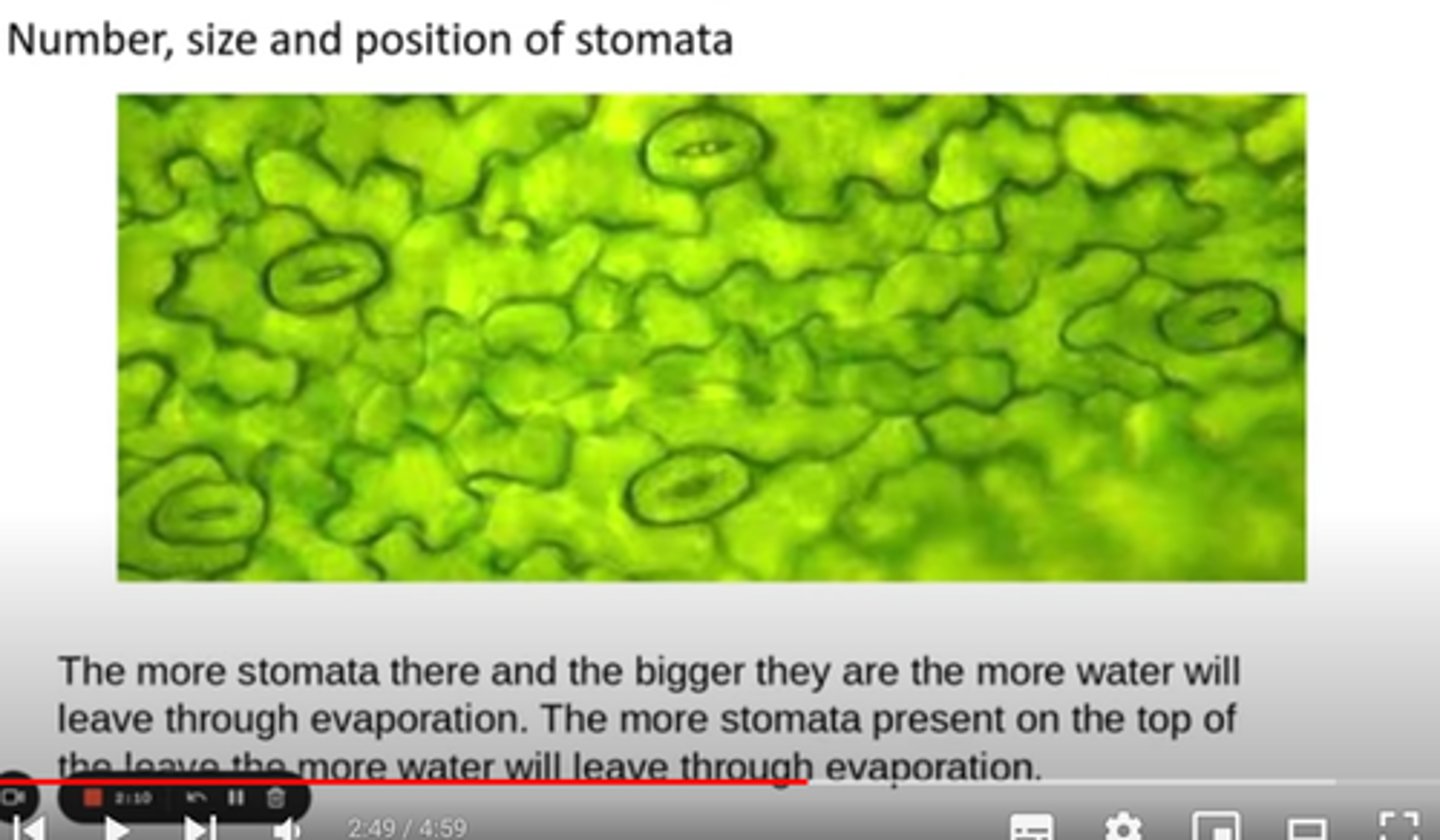
Presence of waxy cuticle
The waxy cuticle is waterproof, and the thicker it is, the less water that will leave through evaporation
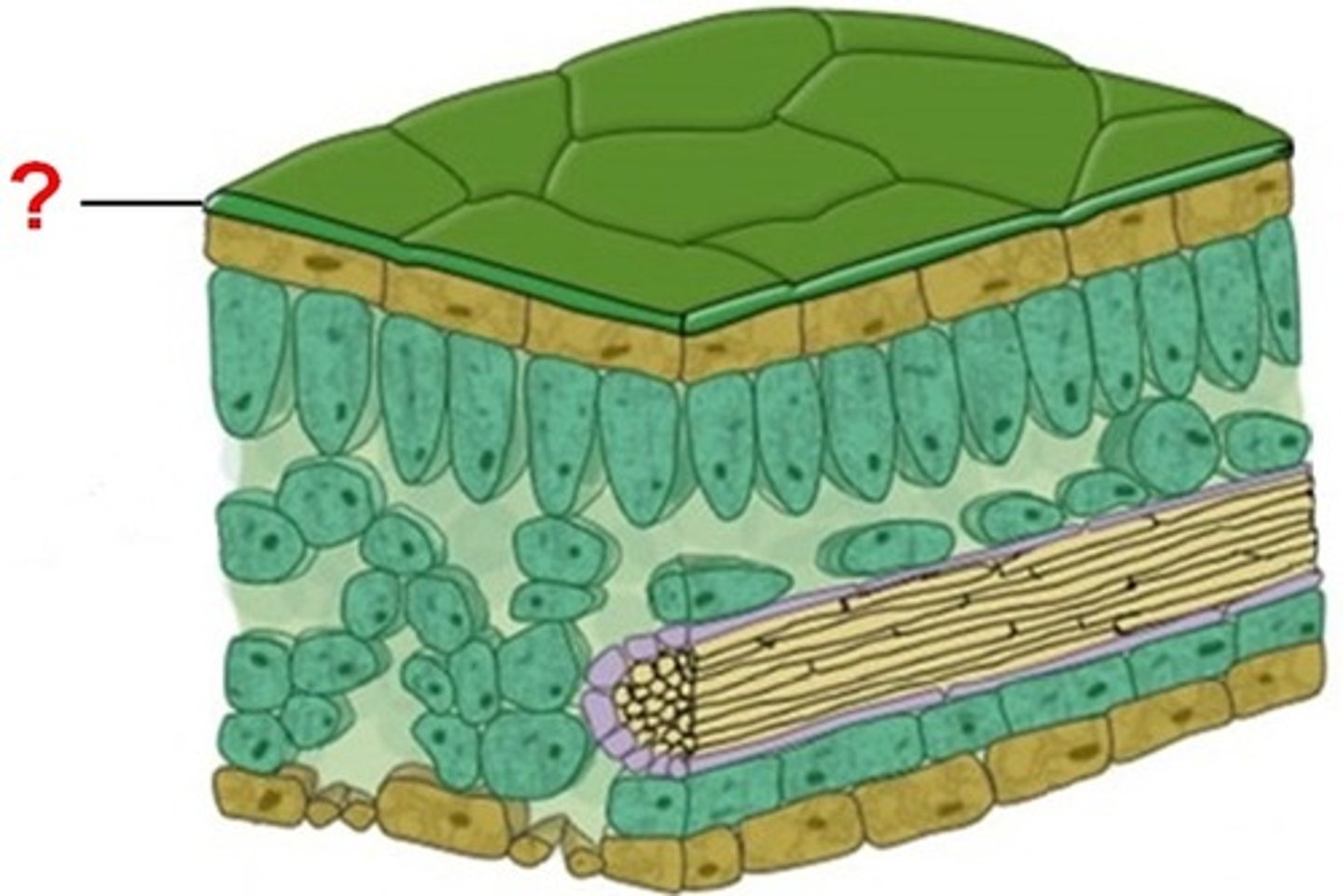
Water availability
The more water available, the more water that will leave through evaporation
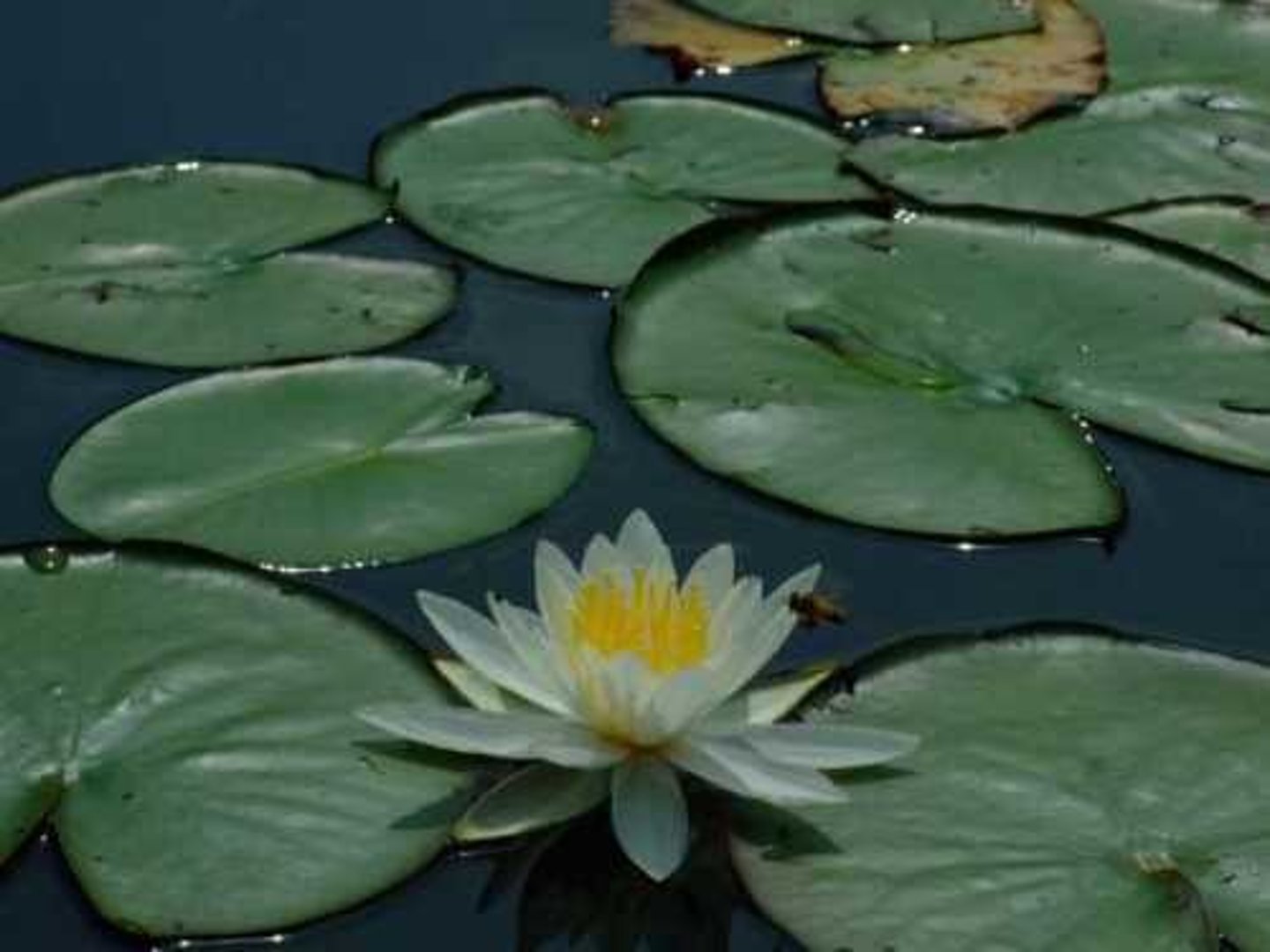
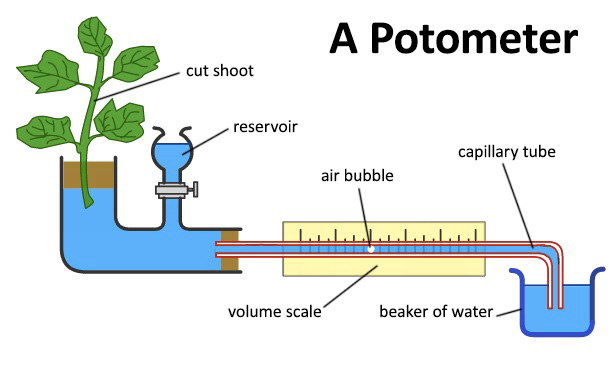
Investigating the Rate of Transpiration Method
Cut stem under water to avoid air bubbles entering the xylem. Cut at an angle to increase the surface area for the xylem to take up the water
Dry the leaves to avoid the reduction in transpiration of the plant
Use the same age/species of plant with the same surface area of leaves
Set up the potometer under water and introduce an air bubble
Why does the potometer not accurately measure the rate of water uptake?
Some water is used in turgor pressure
Some water is used in photosynthesis

What info do I need to calculate the rate of water uptake in the transpiration practical with a potometer?
Surface Area of a Circle x The distance the bubble has moved
Why does water move into the root hair cell via osmosis?
There is a lower water potential in the root hair cells, due to the active transport of mineral ions and salts into the root hair cells, so there is a higher concentration of solutes.
Water moves into the root hair cells by osmosis.
Name the 2 pathways the water takes to get from the root hair cell to the xylem in the vascular bundle
Apoplastic pathway
Symplastic pathway
Apoplastic Pathway
Water travels through the cell wall
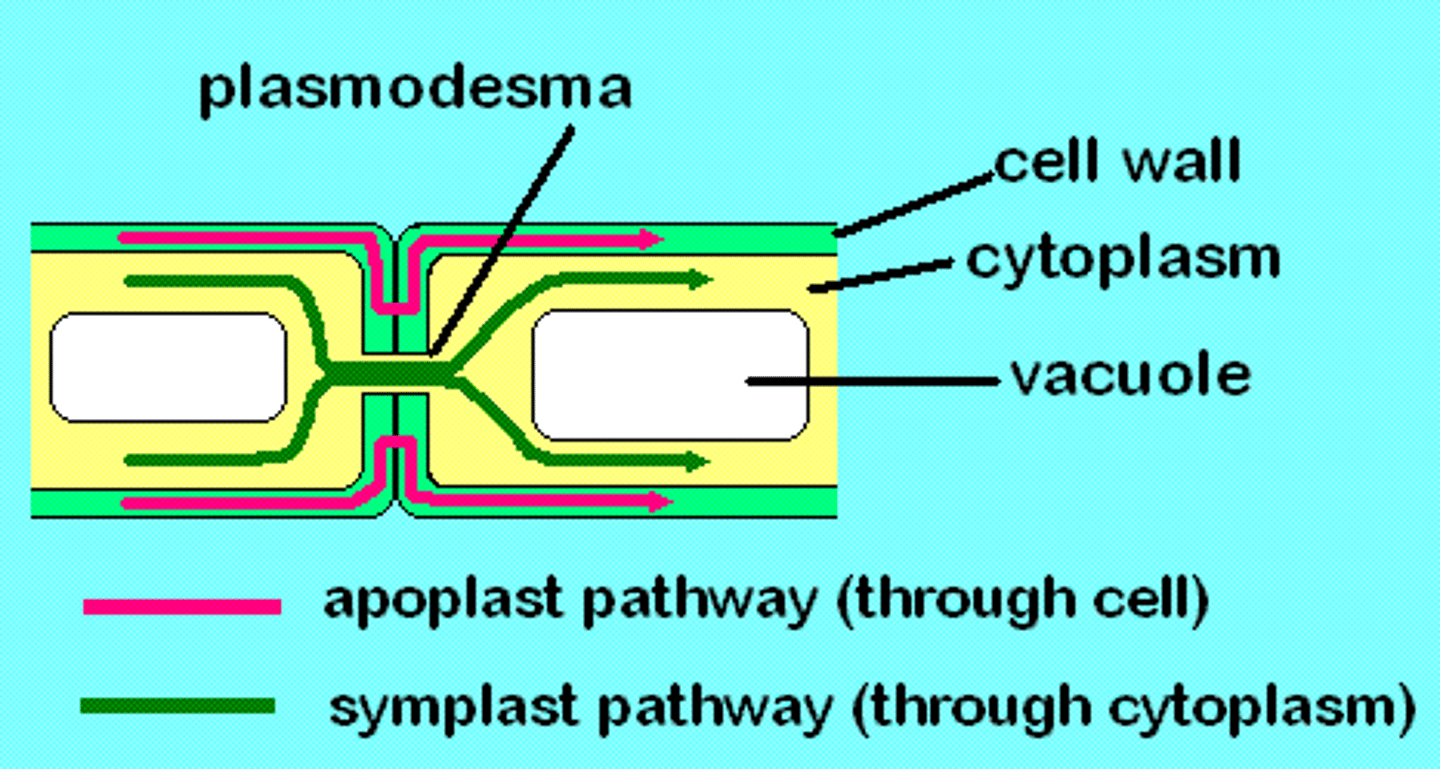
How does water move in the apoplastic pathway?
Via diffusion as it is not crossing a partially permeable membrane
The water stays within the cell walls (apoplastic pathway) until it reaches what?
Casparian strip

Where is the casparian strip?
In the endodermis

What does the casparian strip do?
When the water and dissolved minerals reach the casparian strip, they must take the symplastic pathway.
Symplastic pathway
Water travels through the cytoplasm and pass from cell to cell through the plasmodesmata
Cohesion-Adhesion tension theory
There is high hydrostatic pressure in the roots
There is a low hydrostatic pressure in the leaves
As water evaporates through the stomata, this creates tension in the xylem
Water moves up the xylem in a continuous column along the hydrostatic pressure gradient by cohesion, adhesion, and capillary action.
This is by mass flow
Name some xerophytes
Cacti
Marram grass
Name a hydrophyte
Water lilies
Xerophyte adaptations to reduce water loss:
Rolled leaves
Hairy leaves
Sunken stomata
Needle like leaves
Dense spongy mesophyll layer
Less stomata
Thick waxy cuticle
Long deep root systems
Xerophyte adaptations - Rolled leaves
Reduces surface area for evaporation
Traps a layer of water vapour, creating a higher water potential outside the stomata, reducing the water vapour potential gradient, reducing evaporation of water from the leaves
Xerophyte adaptations -Hairy leaves
Traps a layer of water vapour, creating a higher water potential outside the stomata, reducing the water vapour potential gradient, reducing evaporation of water from the leaves
Xerophyte adaptations -Sunken stomata
Traps a layer of water vapour (it isn’t taken away by the wind as easily), creating a higher water potential outside the stomata, reducing the water vapour potential gradient, reducing evaporation of water from the leaves
Xerophyte adaptations -Needle like leaves
Reduces the surface area of the leaf, therefore less evaporation of water vapour
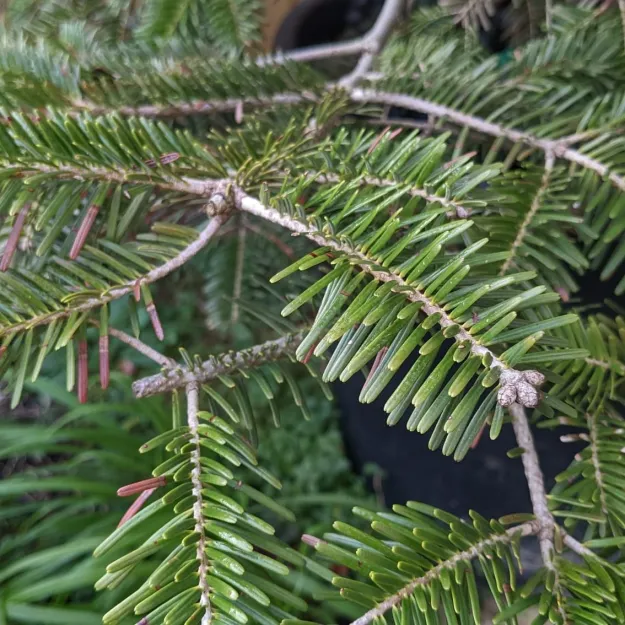
Xerophyte adaptations -Dense spongy mesophyll layer
Smaller surface area for evaporation
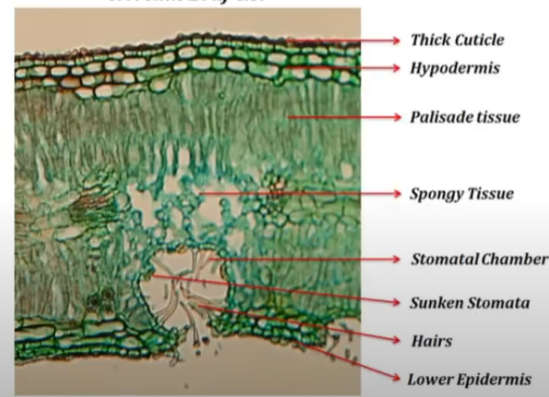
Xerophyte adaptations -Less stomata
Less stomata which are closed in the day
Most of the stomata will be found on the lower surfaces of the leaves to reduce evaporation
Xerophyte adaptations -Thick waxy cuticle
Waterproof, prevents water leaving through evaporation
Xerophyte adaptations -Long deep root systems
Long deep roots to take up water
There are also a high solution concentration in root hair cells to draw more water in via osmosis
Hydrophyte adaptations
Aerenchyma
Large leaves
Pneumatophore
Lots of stomata
Thin waxy cuticle
Short root system
Hydrophyte adaptations - Aerenchyma
Allows buoyancy
Hydrophyte adaptations - Large leaves
Allows large surface area for leaves to increase the rate of photosynthesis
Hydrophyte adaptations - Pneumatophores
Roots that grow out of the water to aid with gas exchange
Increases the rate of photosynthesi
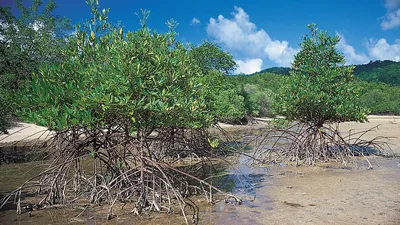
Hydrophyte adaptations - Lots of stomata
Open most of the time
Found on the upper surfaces of the leaves to increase gas exchange
Hydrophyte adaptations - Thin waxy cuticle
No need for a thick waxy cuticle as water loss doesn’t need to be prevented
Hydrophyte adaptations - Short root system
Prevents damage by currents
The plants can meet its requirements for water because it lives in water.
Source
Where sugars are made or released from a carbohydrate source (starch)
Sink
Anywhere in the plant where the sugars are used in respiration or converted for storage (starch in roots) and are therefore in a low concentration
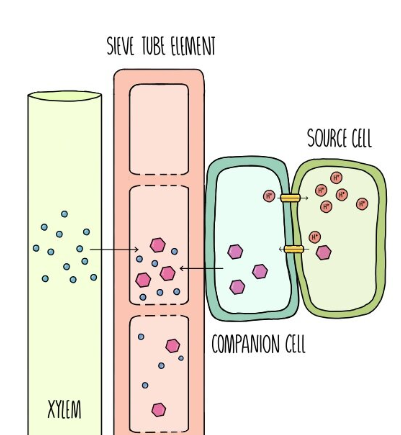
Translocation Process - Active Loading at the Source
H+ ions in the companion cells are actively transported out into surrounding tissue
H+ ions move back into the companion cell with a sucrose (or an amino acid), using a cotransporter protein.
This process is facilitated diffusion
Sucrose diffuses through the plasmodesmata into the sieve tube elements
Mass flow hypothesis. Sucrose lowers the water potential of sieve tube elements and therefore water moves into the sieve tube elements from the xylem via osmosis
This causes an increase in hydrostatic pressure inside the sieve tube elements at the source
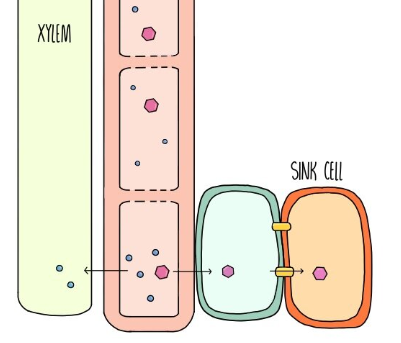
Translocation Process - Removal at the Sink
At the sink, sucrose leaves the sieve tube elements by diffusion and therefore the water potential of the sieve tube elements increases
Therefore water leaves the sieve tube elements via osmosis
This causes a decrease in hydrostatic pressure inside the sieve tube elements at the sink
Because there is a high hydrostatic pressure at the source and low hydrostatic pressure at the sink, what happens?
Assimilates move from source to sink down the hydrostatic pressure gradient by mass flow
